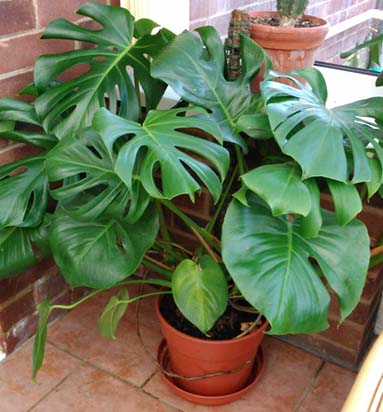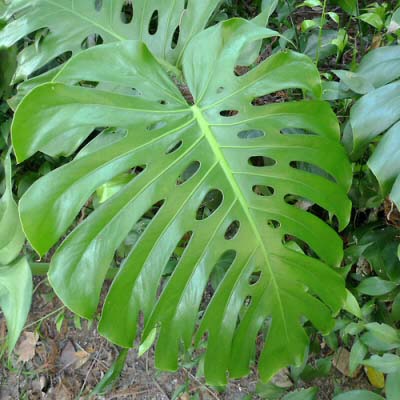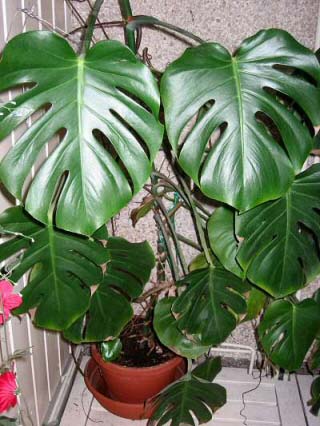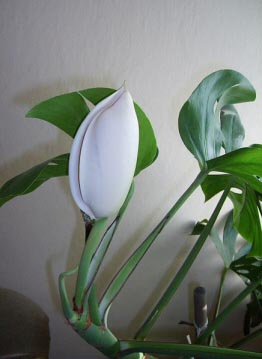





Monstera deliciosa, the Hurricane or Swiss Cheese Plant are all names for an old fashioned but true favorite for many.  Look closely at the Latin name and play around with it a little and you get "Delicious Monster", while it's not at all delicious on the account of its leaves being poisonous, it really is a climbing monster - in size. There's no getting around the fact, while lovely and incredibly easy to care for, it needs space and will roar for it should you not give some. It's not for the window sill or a small flat.
Look closely at the Latin name and play around with it a little and you get "Delicious Monster", while it's not at all delicious on the account of its leaves being poisonous, it really is a climbing monster - in size. There's no getting around the fact, while lovely and incredibly easy to care for, it needs space and will roar for it should you not give some. It's not for the window sill or a small flat.
The Swiss Cheese Plant will inevitably need support indoors, either by way of a moss stick or some stable nearby structure which you can tie it to. For example exposed wall pipes (but not too close or you will scald the leaves!).
It originates from the tropical rainforests of southern Mexico but adapts and positively thrives in the most un tropical of places - our homes. If you've the room, want an easy going, striking and interesting green plant to add to your collection or brighten up a stale boring corner of your home, Monstera deliciosa should be on your shortlist.
As it ages the new leaves become Swiss Cheese like, with cut large ribbons or holes in its leaves, a natural adaptation that has been the subject of intense study over the years.  For those who are interested, it's generally believed leaves cut like this better resist damage from downpours and Hurricane's (or just your standard plain old windy weather - we're just trying to illustrate in how it got its common names), additionally the light reaching down onto the floor of a tropical rainforest is quite low and what does make it through is dappled, so the leaves with these ribbons have a large surface area to better capture what little light filters down.
For those who are interested, it's generally believed leaves cut like this better resist damage from downpours and Hurricane's (or just your standard plain old windy weather - we're just trying to illustrate in how it got its common names), additionally the light reaching down onto the floor of a tropical rainforest is quite low and what does make it through is dappled, so the leaves with these ribbons have a large surface area to better capture what little light filters down.
Although its been around for ages, there are still very few cultivars you can buy. The most common is the original M. deliciosa, but you may find it being incorrectly sold as Philodendron pertusum, or a Split leaf Philodendron especially if the plant you are looking at is very small. Monstera when young will not have the distinct leaf shapes that a mature specimen will develop, so it's easy to confuse it with a general Philodendron.
There is a variegated cultivar called M. deliciosa variegata, which is a little harder and slower to grow, consequently it's rather hard to get hold of. In addition, unlike a lot of variegated houseplants, on the Swiss Cheese Plant the markings don't tend to make it that much more appealing, perhaps because the variegation can be very contrasting and on first glance can make it look like someone has spilled white paint over it. If space is limited but you really want one, look out for M. deliciosa borsigiana or mini, which are the compact varieties.
Light
Gentle sunlight is fine for the Swiss Cheese Plant, but harsh sun needs to be avoided as it will scorch and possibly yellow the leaves.  On the other side of things, dark gloomy corners need to be avoided too in order to prevent loss of the Swiss Cheese effect in the leaves and the annoying spreading effect that occurs in these conditions.
On the other side of things, dark gloomy corners need to be avoided too in order to prevent loss of the Swiss Cheese effect in the leaves and the annoying spreading effect that occurs in these conditions.
Watering
Only average levels of watering is required here. When you do water make sure you aim to get all of the compost evenly moist, then wait until it has dried out some before watering again (don't wait too long though). You'll also need to wait less time between watering's during the warmer months of the year or if the plant has been positioned in a very warm and dry space because all of these things will increase the thirst of your Swiss Cheese Plant.
Humidity
It will take average to high humidity levels well, but will start to suffer if things are very dry for prolonged periods. Find ways that work for you to increase humidity if this is likely to be an issue in the spot you have chosen for it.
Feeding
Feeding is essential if you want new, lush green growth. Normal strength no more than once a month during periods of active growth. Reduce the amount and frequency of feed if you're finding your plant is becoming a monster and outgrowing its home too fast!
Temperature
Active growth will start whenever temperatures are 18°C / 65°F or above. Although it will survive easily between 10°C / 50°F to 30°C / 86°F try to keep in the middle of this where possible to avoid temperature related problems.
Repotting
A new plant in it's first pot will need to be repotted only a short time after purchase, but think really carefully before you decide to upsize the pot of an established one. Because - Big Pots = A Monster Monstera deliciosa.
In any case, as is usual with most houseplants, find a pot which is a bit bigger than the existing one and using new compost pot it up into its new home. Don't feed newly repotted Monsteras for at least three months.
Propagation
You normally won't want more than one of these in your home for obvious reasons, but if you really want to give it a go you can remove the growing tips from stems just below an aerial root. Put the cutting (including the aerial root) in a similar compost mix to what the parent was growing in and maintain similar conditions until established, before moving on to its new home.
Speed of Growth
When the plant is in active growth (depending on temperature this is usually, during the Spring and Summer months) it puts out quite a few new shoots and leaves, especially if properly fed and watered with good light conditions.
Height / Spread
With time comes a humongous beast. Up to 20m / 65ft high and the leaves can often reach between 25–90cm / 9-35 inches both in width and length .
.
Flowers
The Swiss Cheese Plant belongs to the arum family, so the flower it produces is typical in appearance to the many other plants within this group i.e. reasonably unremarkable. Except for two points, firstly if fruits are produced on your Monstera (rare indoors) you can eat them once ripe. Do some research first though, as unripe fruits aren't good for you. The taste is supposed to be a (delicious) cross between banana and pineapple mixed with hints of various other tropical fruits. Secondly a large Monstera will produce a proportionally large flower which can be a fun talking point if not something overly pretty to look at.
Anything Else?
The Swiss Cheese Plant looks fantastic with shiny, polished leaves. Make sure you clean it regularly to keep this attractive look.
Copyright © www.100flowers.win Botanic Garden All Rights Reserved